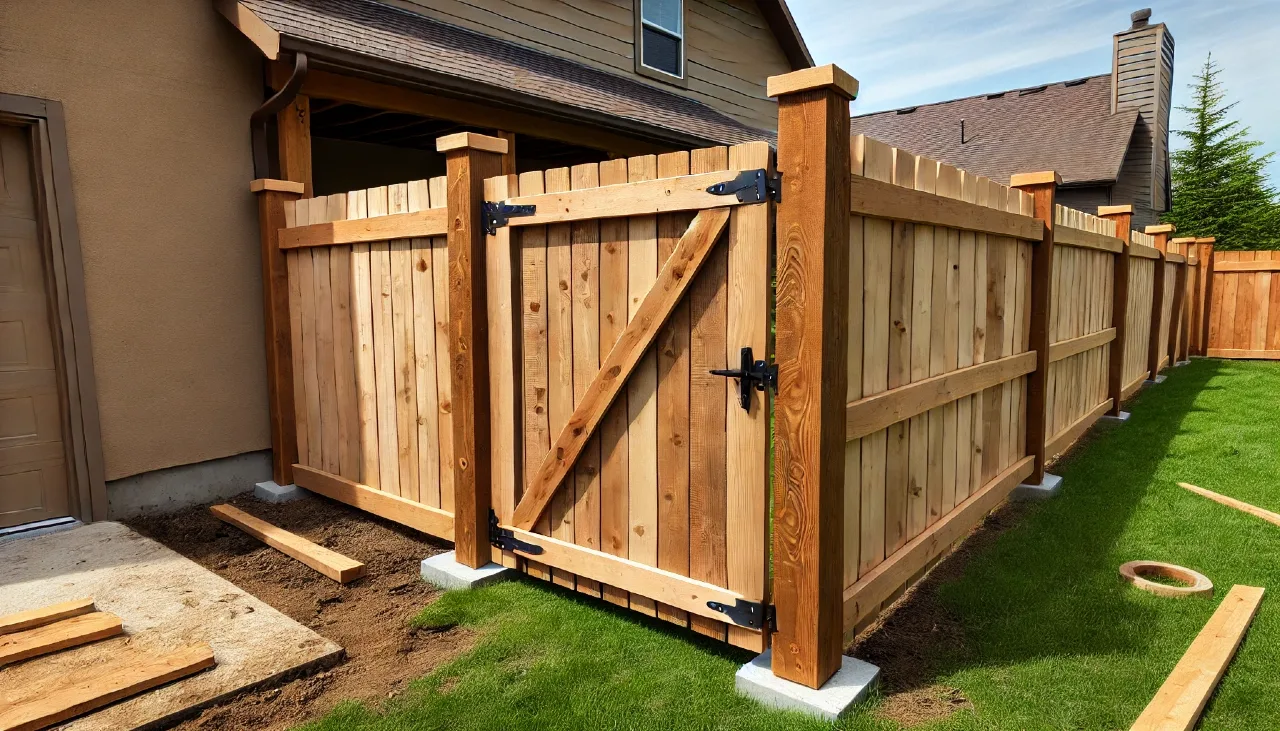A sturdy wooden fence not only enhances the appearance of your property but also provides security and privacy. Building a durable wooden fence requires proper planning, choosing the right materials, and following effective construction techniques. In this guide, we’ll explore how to build a strong and long-lasting wooden fence, from selecting the best wood to securing fence posts and ensuring longevity.
1. Planning Your Wooden Fence Project
Before starting construction, thorough planning is essential. Consider the purpose of the fence—whether it’s for privacy, decoration, or security—and its placement around your property. Understanding local building codes and property lines is also crucial before breaking ground.
Important Planning Steps:
- Check regulations: Investigate local ordinances and homeowner association rules regarding fence height, placement, and materials.
- Determine your fence’s purpose: Privacy, security, or simply marking property boundaries.
- Select the right design: Consider wood fence design ideas based on your goals, such as privacy fences, picket fences, or ranch-style fences.
2. Choosing the Best Wood for Fencing
One of the most critical decisions in building a sturdy wooden fence is selecting the right type of wood. Different woods offer varying degrees of durability, resistance to rot, and visual appeal. Pressure-treated wood for fencing is an excellent choice for durability, but there are other types of wood worth considering.
Recommended Wood Types:
- Cedar: Naturally resistant to rot and insects, cedar is a popular choice for wood fencing. It’s durable and has a warm, attractive appearance.
- Redwood: Known for its beauty and long-lasting properties, redwood is resistant to decay and insects, but it can be more expensive.
- Pressure-treated pine: Treated to resist moisture and pests, pressure-treated wood is highly durable and cost-effective for fencing.
Factors to Consider:
- Durability: Choose wood that can withstand the elements, especially if you live in an area prone to moisture or extreme weather.
- Aesthetics: Different woods have distinct looks, so pick one that complements your property.
3. Gathering Tools and Materials
Having the right tools and materials is crucial for strong wooden fence construction. Here’s a list of essential tools and supplies needed for building a sturdy fence:
Tools:
- Tape measure
- Level
- Post hole digger
- Hammer or nail gun
- Circular saw
- Power drill
- String line and stakes
- Concrete mixer (optional)
- Shovel
Materials:
- Wooden fence posts (4×4 pressure-treated or cedar)
- Wooden fence panels or pickets
- Concrete mix (for securing posts)
- Nails or screws (galvanized for weather resistance)
- Gravel for drainage
- Weatherproof sealant or paint (for finishing)
4. Preparing the Fence Layout
Before digging any holes, it’s essential to mark out your fence layout to ensure straight lines and accurate post spacing. Use a string line and stakes to map out where the fence will be installed, ensuring it aligns with your property boundaries.
Steps to Layout Your Fence:
- Mark your corner posts: Start by placing stakes where your corner posts will be located. These will anchor the entire fence structure.
- Run the string line: Attach the string to the corner posts to create a straight guideline for the rest of the fence posts.
- Mark post locations: Using a measuring tape, mark the locations for the intermediate fence posts. For most residential fences, the recommended fence post spacing is between 6 and 8 feet.
5. Digging and Securing Wooden Fence Posts
The foundation of a sturdy wooden fence lies in the fence posts. Properly digging and securing fence posts is essential to ensure stability and longevity.
Steps for Wooden Fence Post Installation:
- Dig the holes: Using a post hole digger or auger, dig holes at least 1/3 the height of your fence posts. For a 6-foot fence, the holes should be at least 2 feet deep.
- Add gravel: Place 4-6 inches of gravel at the bottom of each hole to improve drainage and prevent the wood from rotting.
- Set the posts: Insert the fence posts into the holes, making sure they are level and aligned with the string line.
- Secure with concrete: Mix the concrete and pour it into the hole around the post. Slope the concrete away from the post to ensure water doesn’t pool at the base.
- Let the concrete set: Allow the concrete to cure for at least 24 hours before attaching any fencing materials.
6. Attaching Wooden Fence Panels or Pickets
Once your posts are set and stable, you can start attaching the fence panels or pickets. Installing wooden fence panels is quicker and provides a uniform appearance, while pickets allow for more customization in design.
Installing Fence Panels:
- Measure and align: Start by measuring the distance between each post to ensure that the fence panels will fit perfectly.
- Secure the panels: Attach each panel to the posts using galvanized nails or screws. Ensure they are level and evenly spaced.
Installing Individual Pickets:
- Start with a corner: Begin by attaching the first picket to a corner post, making sure it’s level.
- Use spacers: Insert spacers between each picket to ensure uniform gaps.
- Secure with nails or screws: Attach each picket to the posts using galvanized fasteners for weather resistance.
7. Building a Sturdy Fence Gate
If your fence includes a gate, constructing a sturdy fence gate is crucial to ensure long-term durability and ease of use.
Tips for Building a Durable Gate:
- Use strong hinges: Choose heavy-duty, rust-resistant hinges that can support the weight of the gate.
- Reinforce the frame: Use diagonal bracing on the gate frame to prevent sagging over time.
- Secure latch: Install a high-quality latch that will remain functional despite exposure to the elements.
8. Weatherproofing and Protecting Your Wooden Fence
Weatherproofing wood fences is essential to protect them from rot, moisture, and UV damage. Properly sealing and maintaining your wooden fence will extend its lifespan and keep it looking great for years.
Steps to Protect Your Fence:
- Apply sealant: Use a high-quality wood sealer or stain to protect the fence from moisture and UV rays. Ensure that all surfaces are coated, including the posts and pickets.
- Reapply regularly: To maintain protection, reseal your fence every 2-3 years, or as needed, depending on weather conditions.
- Prevent rot: Make sure the bottom of the fence doesn’t come into direct contact with the ground to prevent moisture buildup.
9. Maintaining and Reinforcing Your Wooden Fence
Even the best-built fences need regular maintenance to ensure they remain strong and intact. Here are some wood fence maintenance tips to keep your fence in top condition:
Key Maintenance Tips:
- Inspect regularly: Check your fence for signs of damage, such as loose boards or rusted nails, and repair them promptly.
- Prevent rot: Ensure proper drainage around the fence and remove any debris or vegetation that can trap moisture against the wood.
- Reinforce weak areas: Use wood fence bracing techniques to add support where necessary, especially in high-wind areas.
10. Custom Wood Fencing Ideas
For homeowners looking to add a personal touch to their fence, custom wood fencing ideas can offer both functionality and aesthetic appeal. From decorative picket tops to unique patterns, custom designs can make your fence stand out.
Creative Ideas for Custom Fences:
- Decorative tops: Adding lattice or scalloped tops to your fence can enhance privacy while adding a decorative element.
- Incorporate metal accents: Combining wood and metal creates a modern look while enhancing the fence’s durability.
- Artistic patterns: Experiment with horizontal or diagonal picket placement for a contemporary design.
11. Securing Your Wooden Fence Against Wind
In areas prone to high winds, reinforcing your fence is essential to prevent damage or collapse. Securing wooden fences against wind requires specific techniques to ensure stability.
Tips for Wind-Proofing Your Fence:
- Use deeper posts: Digging deeper post holes (up to 3 feet) will provide more stability in high winds.
- Add bracing: Diagonal braces between posts can help distribute wind forces more evenly across the fence.
- Reinforce with metal: Consider adding metal stakes or brackets at key points to add strength without detracting from the fence’s appearance.
12. Final Touches and Enhancements
After building your wooden fence, you can add final touches to enhance both its functionality and visual appeal.
Enhancements to Consider:
- Lighting: Install solar-powered lights on the posts to illuminate the area and add a modern touch.
- Landscaping: Plant shrubs or flowers along the fence to soften its appearance and integrate it with your garden.
- Decorative hardware: Choose decorative hinges and latches for gates to add a custom look.
This guide on building sturdy wooden fencing covers everything you need to know to construct a durable, long-lasting fence. Whether you’re looking for a DIY wooden fence or hiring a professional, these wooden fence construction techniques will ensure a strong and beautiful result that enhances your property for years to come.




